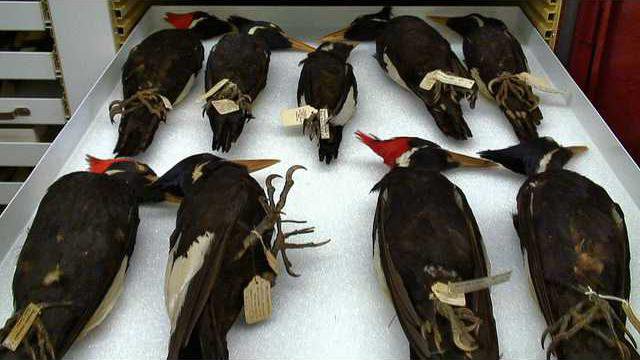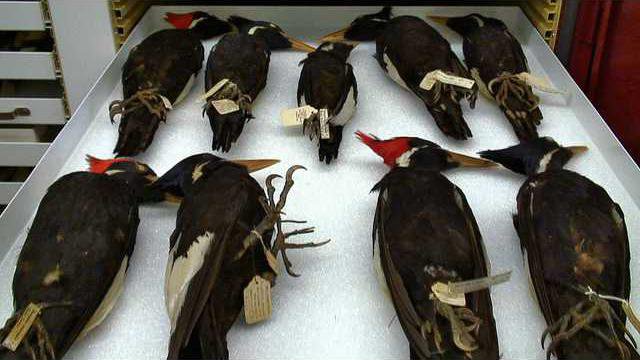Q&A with "Ghost Bird" director-filmmaker Scott Crocker
What: Film documenting the 2004 search for the ivory-billed woodpecker in Arkansas. Includes "Woody Woodpecker" cartoon shorts before screening, Q&A session with Elachee naturalists afterward.
When: 7 p.m. Thursday
Where: Elachee Nature Science Center education hall, 2125 Elachee Drive, Gainesville.
Admission: $10 for adults, $5 students, available online at www.elachee.org or by calling 770-535-1976. Seating is limited.
Online: See the movie trailer; learn more about the ivory-billed woodpecker.
Picture this film concept: A group of adventure seekers tromp off into the wilderness near a small town in search of a mythical creature many claim to have seen or heard, its sounds echoing through the forest sight unseen.
No, it isn't another "Blair Witch" vehicle. Nor is it another Bigfoot sighting. This creature was — and maybe still is — alive and real. And the story is as well.
These searchers weren't looking for a phantom but a bird: the ivory-billed woodpecker, thought to be extinct since the 1930s, then rumored to have been found again in the swampy forests of eastern Arkansas.
"Ghost Bird" is a feature-length documentary about the 2004 search for the bird and its impact. Elachee Nature Science Center in Gainesville will screen the film at 7 p.m. Thursday. The public is invited; seating is limited so call ahead.
The "eco-noir" documentary by filmmaker Scott Crocker follows parallel stories: That of bird experts searching for a species thought to be long gone and the effect the phenomenon had on the 3,000 residents of depressed Brinkley, Ark.
To cash in on its newfound fame, Brinkley was reborn as "Home of the Ivory-Billed Woodpecker," offering woodpecker haircuts, ivory-billed hamburgers and souvenirs, an Ivory-Bill Inn and guided swamp tours.
"Looking at the trailers, (the movie) really focuses on the sighting of this bird and the effect on not just the ornithological community, but also the lives of the folks living in a small eastern Arkansas town," said Peter Gordon, education director at Elachee. "It's a real interesting documentary that should appeal to bird lovers and maybe those not as much into nature."
A New York Times review agrees, calling "Ghost Bird," "a witty, wistful documentary (that turns) a bird-watching tale into a multilayered story that will fascinate practically everybody."
Crocker said his intent was to view the search for the woodpecker and the surrounding hoopla through the eyes of Brinkley's residents as they were thrust into the spotlight.
"The town becomes kind of a stand-in for the rest of us who are not scientists and who are not government funders and who are just watching this story," Crocker said. "And it's in Brinkley's backyard. We can all kind of identify with them and their hopes and aspirations that the bird is there, that they can capitalize on it."
The ivory-bill was thought to have been killed off by the late 1930s after lumber industries denuded its habitat in the late 19th and early 20th centuries. A majestic bird 20 inches tall with a 3-foot wingspan, it was the largest of the woodpecker family, dubbed by bird watchers "The Lord God Bird."
When news of its sightings spread, the Cornell Lab of Ornithology, the National Audubon Society and other groups raised some $10 million for expeditions into the swamp to verify the "ghost bird's" revival. Yet the search turned up no new evidence that the ivory-bill had survived, just snippets of grainy, inconclusive video, audio of what might be the bird's distinctive "double-knock" sound patterns and first-person accounts that added fuel to its legend.
Gordon says he spent time in South Carolina seeking the ivory-bill and can relate to the searchers' difficulty in finding such a reclusive bird. He also hopes the film sheds light on an environmental message.
"This is a bird that was so tied to a specific habitat, the big river bottoms of the Southeast, and when it was destroyed and heavily logged in the early and mid-20th century, the bird had nowhere to go," he said. "It almost brings tears to your eyes to see the last vestiges of the ‘Lord God Bird,' almost a dinosaur-like bird, being reduced to small segments of population. ... We hope the film can spur folks, individuals, governments and nonprofits to rethink land-use policies."
Indeed, that was part of Crocker's intent.
"The bird is a mirror that reflects back to us ... the darkest grim reapers of creation, now that we're sitting in one of the largest waves of species extinction," Crocker said.
So do Gordon or Crocker think the ivory-bill still lives in the far recesses of some Southern woodland?
"Is it out there? It's possible," Gordon said. "Auburn University has done a lot of research in the Panhandle of Florida after some reported sightings down there. ... There are people who have seen the bird, but we're still waiting on that piece of video that will convince everyone."
Said Crocker: "At first I doubted the evidence, but I've had more people come up to me after screenings and swear they've seen the bird, some of them certified ornithologists at universities who have no stake in putting their name out there. So I gotta tell you, if I had more time, I'd go look for it myself."
Adding to the film's aura is a soundtrack that features blues and roots music, alt rock and an original score by Canadian composer and musician Zoe Keating.
Tickets to Thursday's showing are $10 for adults, $5 students, available online or by calling 770-535-1976.
To play on the theme, Gordon says several "Woody Woodpecker" cartoon shorts will be shown before the film, which runs about an hour and 25 minutes. A question-and-answer session with Elachee naturalists will follow.

